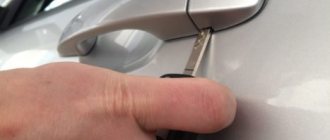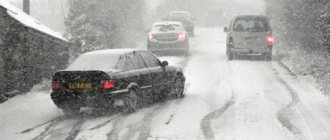AVTOVAZ assures that today’s Lada body is a modern high-tech product, sufficiently protected and always ready for use in our harsh road and climatic conditions. Is this really so? We decided to analyze owner reviews to determine how quickly rust appears on the Lada Vesta body.
How the new Lada Vesta is protected from corrosion
The car body is made of galvanized steel. A cataphoresis primer is applied under the paint layer. The coating is resistant to mechanical stress. The cavities and recesses are treated with an oil-wax composition to prevent corrosion. The bottom and chassis elements are coated with a product that is resistant to humidity and temperature changes.
Checking Vesta for corrosion. Photo source: pikabu.ru
But Lada Vesta has problem areas that require corrosion treatment:
- Too thin a layer of mastic on the bottom, uneven application.
- The gaps at the joints of the body parts were treated with Movil with smudges, unevenly.
- Poor treatment with the compound in the area where the air conditioner breather exits.
- There is no anti-corrosion treatment at the junction of the trunk and rear side member.
- The rear arches do not have lockers, moisture and dirt accumulate on the metal surface.
- The plastic does not fit tightly to the front fender, allowing water to enter the cavity.
- There is no anticorrosive in the upper part of the hood, as well as on the lock.
- The door seal closes the drainage holes, moisture accumulates on the thresholds.
- A very thin layer of protective mastic in the trunk cavities.
The car's protection is no worse than that of its competitors. But it is advisable to additionally treat critical surfaces of the Lada Vesta with an anti-corrosion compound.
Thresholds
The sills on the 4-year-old car turned out to be intact, but it is still worth considering that the dealer performed pre-sale anti-corrosion treatment on this particular example.
The internal cavities were also treated; this photo shows the disassembled trim of the front doors; the yellow coating is an anti-corrosion compound for the internal cavities.
The main places where rust appears on Vesta
Owners of Lada Vesta usually pay attention to the external manifestation of corrosion. But there are many hidden cavities and passages in the car where rust can appear. Standard processing does not last forever and requires periodic updating. The underside of the vehicle is subject to wear and tear due to ingress of solid particles. Additionally, reagents together with moisture can accelerate corrosion.
Corrosion on Vesta. Photo source: olade.ru
Surfaces where Lada Vesta rots:
- hidden body niches;
- uneven welds;
- ceiling steel panels;
- drainage holes;
- gaps under plastic linings;
- areas of body paint damage.
The state of protection of external parts can be assessed visually. A borescope is used to check the general condition of the cavity lining. To inspect the anti-corrosion coating, an ultrasonic thickness gauge is used, or, less commonly, a spark flaw detector.
Problems with the Lada Vesta robot
As for the transmission, the most problematic and at the same time discussed component of the sedan was the robotic gearbox. Mechanical enthusiasts haven’t even considered the version of the car with a “robot,” but fans of automatic transmissions have already managed to actually try out the innovative unit. The disadvantages and disadvantages of the Lada Vesta are twitching, long gear shifts and incomprehensible algorithms for the operation of the gearbox. By the way, ordinary car enthusiasts, along with critics, disliked AMT from the very first days. This gearbox requires a special approach and care. In addition, it takes time to adjust and get a feel for the “robot”, and to adapt your driving style to it. However, many AMT errors can be eliminated by “reflashing” them from the officials.
Why does Lada Vesta rust?
New Lada Vesta cars have good anti-corrosion protection from the factory. But car owners sometimes notice signs of rust. Signs of corrosion are found even in a new car - on the suspension, in the gas removal system. Rust on Vesta appears on uneven weld seams in which dirt accumulates.
This is how the Lada begins to rust. Photo source: youtube.com
The main cause of corrosion is the accumulation of dirt and water in hidden body cavities. These parts are not well treated with protective mastic. Under the influence of reagents, rust occurs very quickly, capturing adjacent areas of the surface. Uneven application of the protective coating also leads to the appearance of pockets of corrosion.
Salon
Those who have driven Vesta for a relatively long time have known that the front-wheel drive family is characterized by rattling interiors, squeaks in the cabin, and they also break quickly. The steering wheel covers are also flimsy - the paint peels off too quickly. Developers have been struggling with these problems for quite a long time, starting from the time of Kalina. In the second generation, they began to apply solutions to reduce interior parts and began to attach them better. Thus, Vesta’s evolution continues, but problems of this nature do not completely disappear.
To this day, owners continue to complain about squeaks. AvtoVAZ promises to fix all problems by:
— changes in fastenings of interior parts;
— change of the dashboard;
Is rust on Vesta covered under warranty?
The Lada Vesta manufacturer assumes certain obligations in the event of corrosion defects being detected. The car owner needs to have completed Lada Vesta coating inspection coupons in the service book. These marks must be entered after the sale in the showroom and then annually throughout the warranty period. The absence of the required document leads to refusal of repair work when corrosion occurs.
The plant provides a 6-year warranty on galvanized surfaces. Car dealers may provide additional benefits to buyers. When the first signs of corrosion appear, the owner of the Lada Vesta needs to contact a service center to repair the damage.
Lada Vesta 2019-2020 owner reviews
- Review
- Prices
- Characteristics
- Photo
- Video
- Reviews
All the disadvantages of Lada Vesta 2019-2020
➖ Crickets in the cabin ➖ Slow acceleration (regarding the version with the 1.6 engine) ➖ Bad wipers
pros
➕ Spacious and comfortable interior ➕ Nice design ➕ High ground clearance ➕ Good handling ➕ Price
The pros and cons of the Lada Vesta 2019-2020 were identified based on reviews from owners who own cars with high mileage. More detailed advantages and disadvantages of the Lada Vesta 1.6 and 1.8 sedan with mechanics, AMT robot and automatic transmission can be found in the stories below.
Reviews
Initially, when starting the engine, the wipers operate once. It seems like nonsense, but not for winter. Also, when starting, the engine seems to “sag”, something goes somewhere. I lost 2 days in the company’s service, they couldn’t understand or fix anything, everything is written off to the factory. When yesterday I spent the last 10 hours in the service center, waiting for what was about to happen, I began to speak in understandable Russian jargon.
My masters completely dismantled and reassembled old cars in such a time. There’s a new car and here’s the problem. We haven't encountered this with others. Conclusion: either again everyone is doing it in Russian, or the servicemen are without heads and hands. I've owned the car for less than a month, it's just a shame. I will wait for the result."
Sergey Morozov, review of Lada Vesta 1.6 (106 hp) MT 2018.
How to protect Lada Vesta from rust
Anti-corrosion treatment extends the service life of the vehicle. This work is carried out as the protective mastic wears out. Corrosion manifests itself faster due to unfavorable climatic conditions and low-quality cheap protection materials. A rusty Lada Vesta can be restored using special protective compounds.
Additional factory anti-corrosion treatment
AvtoVAZ, in the interests of customers, applies additional corrosion protection. Factory processing locations:
- cavity near the scutes;
- the space between the shock absorber mount and the wheel arch;
- hidden space near the side members;
- cavity behind the sidewall trim;
- junction of the sill trim;
- cavity in the floor under the rear seat;
- luggage lid panels;
- cavities in door openings;
- hood panels.
In addition to the indicated places, the factory additionally processes body fasteners, holes and surface joints.
Processing in a car service
Good quality anti-corrosion protection can be provided by specialists involved in maintenance of Lada Vesta Cross, SW and sedan. Before treatment, the exterior and hidden cavities of the vehicle are thoroughly washed to remove dirt. Dry the car until moisture is completely removed from the surface.
Fret processing. Photo source: 37autoservis.ru
Procedure for applying anti-corrosion protection:
- Installing the car on a lift.
- Dismantling of plastic linings and protective aprons, seals.
- Dismantling the trunk trim, cleaning the cavity with a vacuum cleaner from debris and dirt.
- Cleaning rotten areas of the body. Treatment with primary anti-corrosion primer.
- Placing the car in a special chamber for spraying anticorrosive. Removing wheels. Installing covers on drive mechanisms, hoses and electrical wiring harnesses.
- Spraying an anti-corrosion agent onto the surface. Treatment of hidden cavities with a spray gun according to the manual scheme.
- Cleaning fresh compound from paintwork and plastic parts. Assembly of wheels, protective linings and seals.
- Dry the composition for 3-5 hours at room temperature.
When the protection dries, the car must not be moved. The thickness of the layer of applied composition is checked with a thickness gauge.
Do-it-yourself Vesta protection from corrosion
The car usually does not need additional rust treatment for the first 3 years. But it is better to check the condition of the coating annually. Protective compounds for metal surfaces:
- Underbody materials with gravel protection function. The composition must contain inhibitors and have noise-absorbing properties. Bitumen mastic with filler is suitable for this.
- The anti-corrosion composition of the wheel arch coating must be resistant to abrasive wear of the surface. A “liquid locker” or applying bitumen mastic in 2-3 layers is suitable for processing.
- Treatment of hidden cavities is carried out with liquid anticorrosive agent. The composition effectively displaces moisture and forms a dense film on the metal.
The use of high-quality compounds will protect the car from rust for 2-3 years.
Body galvanization
Body galvanizing technology is the most effective. During this process, the car body is dipped into a bath filled with molten zinc. The temperature of the solution ranges from 445-460 °C. However, this method is also the most expensive. In the West, automakers galvanize about 95% of the bodies of their models. AvtoVAZ does not yet consider it possible to use such a method, since this implies large-scale modernization measures at the plants’ facilities and significant investments. In addition, the cost of galvanizing will affect the final cost of Lada cars.
Choice of anticorrosive: compositions and prices
There are a lot of rust protection methods - from simple products to expensive imported mastics:
- Anticorrosive on Vesta is prepared with your own hands from “Gun Lard” and “Cordon” mastic. The total cost of the mixture is about 400 rubles per 1 kg. The product is applied to the surface with a brush.
- The product “Reduced lead ship” covers the surface with an oxide film. Price – 400 rubles per jar.
- Universal “Glue 88” is applied to a degreased surface. The water-repellent film reliably protects metal parts. The cost of glue is up to 400 rubles per package.
- Dinitrol sealant contains inhibitors and anti-gravel additives. Mastic has noise insulating properties. Packaging price – 1150 rubles.
- Anticorrosive Hi Gear contains rubber filler and additives that neutralize road reagents. Cost up to 400 rubles.
- The protective coating "Noksidol" is universal, also suitable for treating hidden cavities. The price of the package is about 700 rubles.
- LIQUI MOLY anti-corrosion agent is used even for old cars. Double application of mastic reliably protects against rust. The cost of the can is less than 500 rubles.
- Liquid Supra Shield easily penetrates into hidden cavities, displaces water and forms a durable protective film. The price of anticorrosive agent is low - 200 rubles per liter.
When choosing protection, it is necessary, in addition to the cost of the product, to take into account the condition of the surface.
Four types of technologies
A little about why zinc (Zn) protects steel - it is a non-ferrous metal, has a more negative potential and corrodes first (that is, when it collapses, it protects the coating underneath), and the protection works even when it is damaged or partially destroyed.
It becomes clear that the larger and thicker the zinc layer, the longer the car body is preserved and no corrosion occurs.
To apply particles of protective metal to the body, there are only four main technologies, I will list them from best to worst.
- Hot method. When the fully assembled body is dipped into a bath filled with zinc. Moreover, the temperature stays around 460 – 500 degrees Celsius. The method is very expensive and costly. Used by expensive brands on luxury cars - PORSHE, VOLVO, now on some premium HYUNDAI, etc.
- Galvanic method. The method consists in the process of deposition on the cathode (in our case, part of the body), positively charged particles (ions) of zinc from aqueous solutions (electrolytes). This technology works by passing a direct electric current through it. This is a less expensive and simpler technology, used by Mercedes, BMW, TOYOTA, Honda, Mitsubishi, KIA, etc.
- Zinc metal. It is used mainly by KIA, on cars from the “C” class. This is a kind of plastic coating that consists of two layers.
- Cold method. In essence, this is a kind of painting. A powder is applied to the body parts, which contains small particles of zinc powder. Used by many brands (Chevrolet, KIA, HYUNDAI, TOYOTA) including AVTOVAZ.











